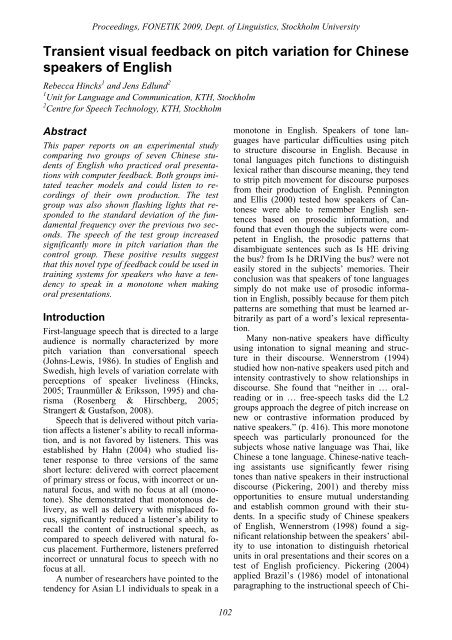Proceedings Fonetik 2009 - Institutionen för lingvistik
Proceedings Fonetik 2009 - Institutionen för lingvistik
Proceedings Fonetik 2009 - Institutionen för lingvistik
You also want an ePaper? Increase the reach of your titles
YUMPU automatically turns print PDFs into web optimized ePapers that Google loves.
<strong>Proceedings</strong>, FONETIK <strong>2009</strong>, Dept. of Linguistics, Stockholm UniversityTransient visual feedback on pitch variation for Chinesespeakers of EnglishRebecca Hincks 1 and Jens Edlund 21 Unit for Language and Communication, KTH, Stockholm2 Centre for Speech Technology, KTH, StockholmAbstractThis paper reports on an experimental studycomparing two groups of seven Chinese studentsof English who practiced oral presentationswith computer feedback. Both groups imitatedteacher models and could listen to recordingsof their own production. The testgroup was also shown flashing lights that respondedto the standard deviation of the fundamentalfrequency over the previous two seconds.The speech of the test group increasedsignificantly more in pitch variation than thecontrol group. These positive results suggestthat this novel type of feedback could be used intraining systems for speakers who have a tendencyto speak in a monotone when makingoral presentations.IntroductionFirst-language speech that is directed to a largeaudience is normally characterized by morepitch variation than conversational speech(Johns-Lewis, 1986). In studies of English andSwedish, high levels of variation correlate withperceptions of speaker liveliness (Hincks,2005; Traunmüller & Eriksson, 1995) and charisma(Rosenberg & Hirschberg, 2005;Strangert & Gustafson, 2008).Speech that is delivered without pitch variationaffects a listener’s ability to recall information,and is not favored by listeners. This wasestablished by Hahn (2004) who studied listenerresponse to three versions of the sameshort lecture: delivered with correct placementof primary stress or focus, with incorrect or unnaturalfocus, and with no focus at all (monotone).She demonstrated that monotonous delivery,as well as delivery with misplaced focus,significantly reduced a listener’s ability torecall the content of instructional speech, ascompared to speech delivered with natural focusplacement. Furthermore, listeners preferredincorrect or unnatural focus to speech with nofocus at all.A number of researchers have pointed to thetendency for Asian L1 individuals to speak in amonotone in English. Speakers of tone languageshave particular difficulties using pitchto structure discourse in English. Because intonal languages pitch functions to distinguishlexical rather than discourse meaning, they tendto strip pitch movement for discourse purposesfrom their production of English. Penningtonand Ellis (2000) tested how speakers of Cantonesewere able to remember English sentencesbased on prosodic information, andfound that even though the subjects were competentin English, the prosodic patterns thatdisambiguate sentences such as Is HE drivingthe bus? from Is he DRIVing the bus? were noteasily stored in the subjects’ memories. Theirconclusion was that speakers of tone languagessimply do not make use of prosodic informationin English, possibly because for them pitchpatterns are something that must be learned arbitrarilyas part of a word’s lexical representation.Many non-native speakers have difficultyusing intonation to signal meaning and structurein their discourse. Wennerstrom (1994)studied how non-native speakers used pitch andintensity contrastively to show relationships indiscourse. She found that “neither in … oralreadingor in … free-speech tasks did the L2groups approach the degree of pitch increase onnew or contrastive information produced bynative speakers.” (p. 416). This more monotonespeech was particularly pronounced for thesubjects whose native language was Thai, likeChinese a tone language. Chinese-native teachingassistants use significantly fewer risingtones than native speakers in their instructionaldiscourse (Pickering, 2001) and thereby missopportunities to ensure mutual understandingand establish common ground with their students.In a specific study of Chinese speakersof English, Wennerstrom (1998) found a significantrelationship between the speakers’ abilityto use intonation to distinguish rhetoricalunits in oral presentations and their scores on atest of English proficiency. Pickering (2004)applied Brazil’s (1986) model of intonationalparagraphing to the instructional speech of Chi-102
















